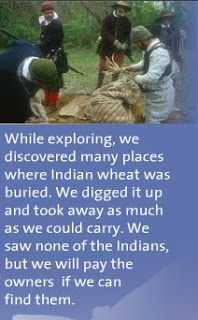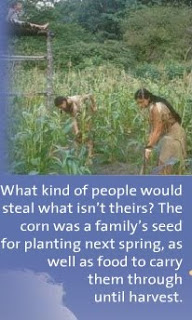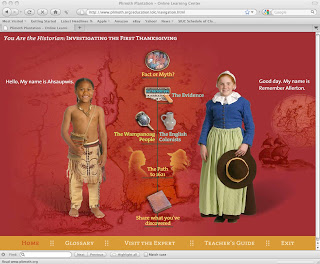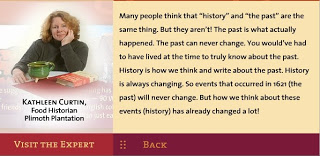Social Sciences
October is nearing its end, and soon jack-0'-lanterns will give way to images of cornucopias, pilgrims, and Wampanoags (or the more common misrepresentation of Indians with feathers and tipis). In the 1990s, publications such as James Loewen's book, Lies My Teacher Told Me--and its revealing chapter, "The Truth About the First Thanksgiving"--raised the consciousness of many teachers who wanted to teach an alternative perspective to the usual narrative about the pilgrim's journey to a "Brave New World." But what kind of content is appropriate in an elementary or middle school classroom? Loewen speaks of grave robbing, cannibalism, disease, and the hijacking theory.
 Colonist perspective from plimoth.org
Colonist perspective from plimoth.org
 Wampanoag perspective from plimoth.org
Wampanoag perspective from plimoth.org
Is this they way we want students, adorned in black hats or feathers made of construction paper, to portray the beloved pilgrims and Wampanoags in a third-grade Thanksgiving play? This question is the kind of initial resistance many elementary teachers in my methods courses have when responding to Loewen's criticisms and similar curricula (e.g., Rethinking Schools). Fortunately, historical sites such as Plimoth Plantation are pushing the alternative perspectives approach and (even better) are giving students the opportunity to examine the evidence. Since few students outside of the New England area get the opportunity to visit the historic site, Plimoth Plantation has created an excellent online learning module that lets students sift through facts and myths to re-envision the history of the First Thanksgiving. Activities such as the "Path to 1621" let the user examine how the Wampanoag and the settlers viewed similar events quite differently. More importantly, in the section, "The Evidence," students get to examine the only source that mentions (and vaguely, at best) the First Thanksgiving.
 Online learning module from plimoth.org
Online learning module from plimoth.org
An important question students should ask is, "Why do we recognize the 1620 settlement of Plimoth as the site for the First Thanksgiving?" It is because it was the first non-Native settlement in the present-day United States? (In 1526, enslaved Africans abandoned by their Spanish captors attempted a settlement in what is now South Carolina.) Is it because it is the first settlement established for religious freedom? (Spanish Jews settled what is now New Mexico in the late 1500s). Is it because it was the first English Colony? (English entrepreneurs settled Jamestown in 1607.) Or does it have more to do with what happened in 1863? (See Loewen, 2007, Lies My Teacher Told Me, pp. 71 & 90.)
 An important message from plimoth.org: "Past" and "History" are NOT synonyms
An important message from plimoth.org: "Past" and "History" are NOT synonyms
- Invitation To Participate In The Humanities Extension Program: Note From Melonie St. John
Colleagues, Melonie St. John in the Nonprofits Institute is managing the Humanities Extension Program. This is a great opportunity to share your knowledge with teachers and students in nearby schools; for those of you who have included K-12 outreach as...
- Back To School (with Common Core, Historical Thinking, Rti, Parcc...)
Yikes. It looks like I have been on a bit of a hiatus and not keeping up with posts about resources... Anyway, I recently emailed some newer resources with a former student who graduated in 2010 and is now gainfully employed at a great school (congrats...
- More Gis
I've admittedly been away from my posting for too long, and the number of amazing resources out there continues to proliferate. I have a lot of catching up to do, so here's a start... Let's talk about Geography Geography is not memorizing...
- Don't Buy A Textbook
Stanford History Education Group's Reading Like a Historian I recently received an email from a Superintendent in Massachusetts. It was time to buy an American history textbook series, and he wanted to know if I had any suggestions. My quick answer...
- Historical Thinking Matters
One of the best free Websites available that adequately scaffolds students' evaluation, corroboration, and synthesis of multiple conflicting sources (yes, the full package of historical thinking) is Sam Wineburg's recent digital project, Historical...
Social Sciences
The First Thanksgiving
October is nearing its end, and soon jack-0'-lanterns will give way to images of cornucopias, pilgrims, and Wampanoags (or the more common misrepresentation of Indians with feathers and tipis). In the 1990s, publications such as James Loewen's book, Lies My Teacher Told Me--and its revealing chapter, "The Truth About the First Thanksgiving"--raised the consciousness of many teachers who wanted to teach an alternative perspective to the usual narrative about the pilgrim's journey to a "Brave New World." But what kind of content is appropriate in an elementary or middle school classroom? Loewen speaks of grave robbing, cannibalism, disease, and the hijacking theory.
 Colonist perspective from plimoth.org
Colonist perspective from plimoth.org Wampanoag perspective from plimoth.org
Wampanoag perspective from plimoth.org Online learning module from plimoth.org
Online learning module from plimoth.org An important message from plimoth.org: "Past" and "History" are NOT synonyms
An important message from plimoth.org: "Past" and "History" are NOT synonyms- Invitation To Participate In The Humanities Extension Program: Note From Melonie St. John
Colleagues, Melonie St. John in the Nonprofits Institute is managing the Humanities Extension Program. This is a great opportunity to share your knowledge with teachers and students in nearby schools; for those of you who have included K-12 outreach as...
- Back To School (with Common Core, Historical Thinking, Rti, Parcc...)
Yikes. It looks like I have been on a bit of a hiatus and not keeping up with posts about resources... Anyway, I recently emailed some newer resources with a former student who graduated in 2010 and is now gainfully employed at a great school (congrats...
- More Gis
I've admittedly been away from my posting for too long, and the number of amazing resources out there continues to proliferate. I have a lot of catching up to do, so here's a start... Let's talk about Geography Geography is not memorizing...
- Don't Buy A Textbook
Stanford History Education Group's Reading Like a Historian I recently received an email from a Superintendent in Massachusetts. It was time to buy an American history textbook series, and he wanted to know if I had any suggestions. My quick answer...
- Historical Thinking Matters
One of the best free Websites available that adequately scaffolds students' evaluation, corroboration, and synthesis of multiple conflicting sources (yes, the full package of historical thinking) is Sam Wineburg's recent digital project, Historical...
